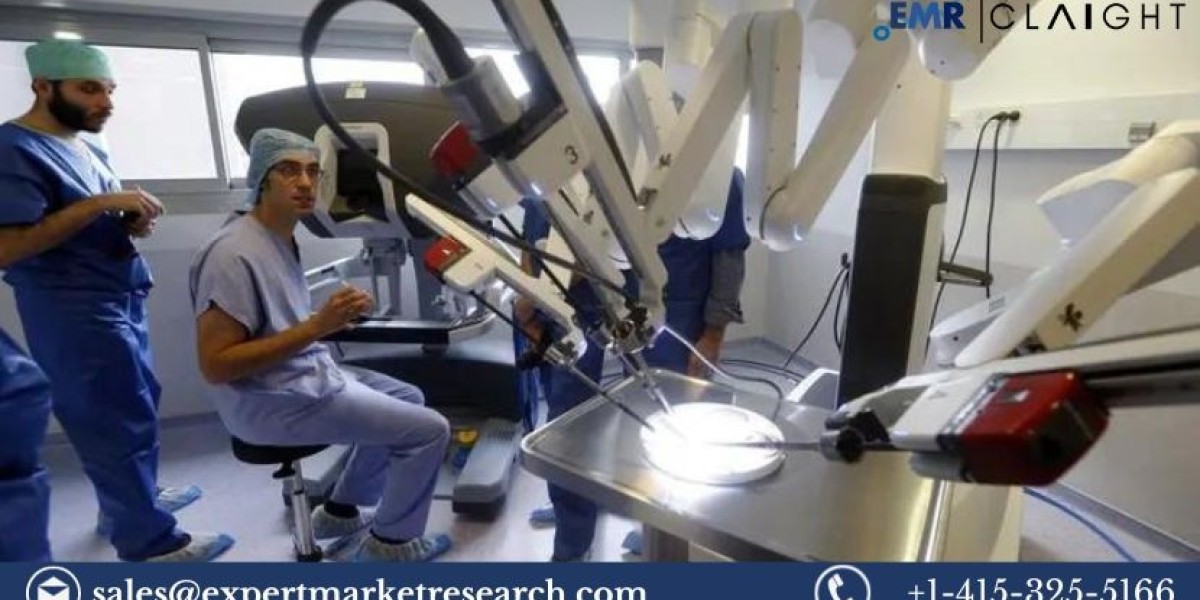Surgical robots represent one of the most revolutionary advancements in modern healthcare, transforming the landscape of surgical procedures with precision, flexibility, and control that surpasses traditional methods. These robots are designed to perform complex surgeries with minimal invasiveness, reducing recovery times and improving patient outcomes. As of 2023, the global surgical robots market was valued at USD 7.40 billion, driven by an increasing demand for minimally invasive surgeries. The market is expected to grow at a compound annual growth rate (CAGR) of 15.7% from 2024 to 2032, reaching a value of USD 27.51 billion by 2032.
Market Overview
The surgical robots market encompasses the development, production, and implementation of robotic systems used in surgical procedures. This market includes various components such as robotic systems, instruments and accessories, and services provided for the maintenance and training related to these systems. Historically, the market has seen significant growth due to advancements in technology and a rising preference for minimally invasive procedures, which are less painful and have quicker recovery times compared to traditional surgeries.
Market Dynamics
Drivers
- Increasing Demand for Minimally Invasive Surgeries: Patients and healthcare providers are increasingly opting for minimally invasive surgeries due to their numerous benefits, including reduced scarring, lower risk of infection, and faster recovery times.
- Technological Advancements: Continuous innovations in robotic technologies, such as enhanced imaging systems, artificial intelligence, and machine learning, are driving the market forward. These advancements allow for more precise and controlled surgical procedures.
- Rising Prevalence of Chronic Diseases: The growing incidence of chronic diseases like cancer, cardiovascular diseases, and diabetes necessitates surgical interventions, thereby boosting the demand for surgical robots.
Restraints
- High Costs: The high initial investment required for purchasing surgical robots and the additional costs of maintenance and training can be prohibitive for many healthcare facilities, particularly in developing regions.
- Limited Skilled Professionals: The effective use of surgical robots requires specialized training and expertise, which are currently limited, thereby hindering widespread adoption.
Opportunities
- Emerging Markets: Developing regions with improving healthcare infrastructures present significant growth opportunities. Increased healthcare expenditure and government initiatives in these regions are expected to drive market expansion.
- Expansion of Robotic Applications: As research continues, the application of robotic systems is expanding beyond general surgery into specialized fields such as gynecology, urology, orthopedics, and neurosurgery, offering new growth avenues.
Challenges
- Regulatory Hurdles: The approval process for new robotic systems can be lengthy and complex, posing a challenge for manufacturers.
- Integration Issues: Ensuring that new robotic systems are compatible with existing healthcare infrastructure and electronic health record systems can be challenging.
Market Trends
The surgical robots market is characterized by several key trends:
- Technological Advancements: The integration of artificial intelligence and machine learning into surgical robots enhances their precision and efficiency. Innovations such as augmented reality and 3D imaging are further improving surgical outcomes.
- Adoption in Outpatient Settings: There is a growing trend towards the use of surgical robots in outpatient and ambulatory surgical centers, driven by their cost-effectiveness and convenience.
- Collaborations and Partnerships: Major players in the market are increasingly forming strategic partnerships and collaborations to enhance their product offerings and expand their market presence.
Get a Free Sample Report with Table of Contents - https://www.expertmarketresearch.com/reports/surgical-robots-market/requestsample
Market Segmentation
By Component
- Surgical Systems: These include the robotic systems themselves, which consist of a surgeon's console, a patient-side cart, and a vision system.
- Accessories: Instruments and accessories used during robotic surgeries, such as endoscopes, forceps, and trocars.
- Services: Maintenance services and training programs provided to ensure the optimal functioning of surgical robots and the proficiency of the operating staff.
By Application
- General Surgery: Procedures involving the abdomen, digestive tract, and other general surgical areas.
- Gynecology: Surgeries related to the female reproductive system, such as hysterectomies.
- Urology: Surgeries involving the urinary tract and male reproductive organs.
- Orthopedics: Procedures involving the musculoskeletal system.
- Neurosurgery: Surgeries on the brain and nervous system.
- Others: Includes cardiothoracic surgery, pediatric surgery, and more.
By End-User
- Hospitals: The primary end-users of surgical robots, with a significant portion of installations and procedures performed in hospital settings.
- Ambulatory Surgical Centers: These centers are increasingly adopting surgical robots due to their cost-effectiveness and ability to handle less complex procedures.
- Others: Includes specialty clinics and research institutions.
Regional Analysis
North America
- Market Size and Growth Rate: North America holds the largest share of the surgical robots market, driven by the presence of major market players, advanced healthcare infrastructure, and high healthcare expenditure.
- Key Drivers and Trends: The region benefits from strong research and development activities, early adoption of new technologies, and favorable reimbursement policies.
Europe
- Market Size and Growth Rate: Europe is the second-largest market for surgical robots, with significant contributions from countries like Germany, the UK, and France.
- Key Drivers and Trends: The market is driven by increasing investments in healthcare, rising demand for minimally invasive surgeries, and technological advancements.
Asia-Pacific
- Market Size and Growth Rate: Asia-Pacific is the fastest-growing region in the surgical robots market, with significant potential in countries like China, Japan, and India.
- Key Drivers and Trends: The growth is attributed to improving healthcare infrastructure, increasing healthcare expenditure, and a growing patient population requiring surgical interventions.
Latin America
- Market Size and Growth Rate: The Latin American market is growing steadily, with Brazil and Mexico being major contributors.
- Key Drivers and Trends: The market growth is driven by increasing healthcare awareness, rising medical tourism, and improving healthcare facilities.
Middle East & Africa
- Market Size and Growth Rate: The Middle East & Africa region holds a smaller share of the global market but is expected to witness significant growth.
- Key Drivers and Trends: The growth is driven by increasing healthcare investments, government initiatives to improve healthcare services, and a rising focus on advanced medical technologies.
Competitor Analysis
The global surgical robots market is highly competitive, with several key players dominating the landscape. The major companies include:
Intuitive Surgical Inc.
- Company Profile and Market Share: Intuitive Surgical is a leading player in the surgical robots market, known for its da Vinci Surgical System. The company holds a significant market share due to its innovative products and strong brand reputation.
- Key Products and Recent Developments: The da Vinci system is widely used in various surgical procedures. Recent developments include advancements in robotic arms and instruments, enhancing the precision and versatility of the system.
Stryker
- Company Profile and Market Share: Stryker is another major player, with a strong presence in the orthopedic and general surgery segments. The company’s Mako robotic-arm assisted surgery platform is highly regarded.
- Key Products and Recent Developments: The Mako system is used for joint replacement surgeries. Recent advancements include the integration of 3D imaging and improved surgical planning tools.
Johnson & Johnson Services, Inc.
- Company Profile and Market Share: Johnson & Johnson, through its subsidiary Ethicon, is a significant player in the surgical robots market. The company’s focus is on developing comprehensive surgical solutions.
- Key Products and Recent Developments: The company’s products include the VELYS Robotic-Assisted Solution for orthopedic surgeries. Recent developments involve enhancing robotic precision and expanding the range of surgical applications.
Medtronic
- Company Profile and Market Share: Medtronic is a global leader in medical technology, with a growing presence in the surgical robots market. The company’s Hugo robotic-assisted surgery platform is gaining traction.
- Key Products and Recent Developments: The Hugo system is designed for a variety of surgical procedures, with recent developments focusing on improving system integration and user interface.
A comparative analysis of these competitors reveals a dynamic market landscape, with companies continuously innovating and expanding their product portfolios to maintain a competitive edge.
Market Forecast (2024-2032)
The global surgical robots market is expected to grow significantly during the forecast period, driven by various factors such as technological advancements, increasing demand for minimally invasive surgeries, and expanding applications in different surgical fields. By 2032, the market is projected to reach USD 27.51 billion, growing at a CAGR of 15.7%.
Key Factors Influencing Future Market Trends
- Technological Innovations: Ongoing research and development activities will lead to the introduction of more advanced and efficient robotic systems.
- Regulatory Approvals: Faster and more streamlined regulatory processes will facilitate the quicker adoption of new technologies.
- Increasing Healthcare Expenditure: Growing investments in healthcare infrastructure, especially in emerging markets, will drive market growth.
Predictions for Technological Advancements
- Artificial Intelligence and Machine Learning: Enhanced AI algorithms will improve the precision and efficiency of surgical robots.
- Augmented Reality and 3D Imaging: The integration of AR and 3D imaging will provide surgeons with better visualization and control during procedures.
Recent Developments
The surgical robots market has seen several significant developments in recent years:
- Product Launches and Innovations: Companies are continuously launching new products with advanced features to improve surgical outcomes.
- Strategic Mergers and Acquisitions: Major players are acquiring smaller companies to expand their product portfolios and market presence.
- Regulatory Approvals: The approval of new robotic systems and accessories by regulatory authorities is facilitating market growth.
- Market Entry Strategies: Companies are entering new markets and regions, focusing on expanding their customer base and increasing market penetration.
FAQs
What are surgical robots?
Surgical robots are advanced medical devices designed to assist surgeons in performing complex surgical procedures with greater precision, flexibility, and control than traditional methods. They typically consist of a surgeon's console, a patient-side cart, and a vision system that provides high-definition 3D images of the surgical site.
How do surgical robots improve surgical outcomes?
Surgical robots improve surgical outcomes by enabling minimally invasive procedures, which result in smaller incisions, reduced blood loss, lower risk of infection, and faster recovery times for patients. The enhanced precision and control provided by robotic systems also reduce the likelihood of surgical errors.
What are the key factors driving the growth of the surgical robots market?
The growth of the surgical robots market is driven by several factors, including the increasing demand for minimally invasive surgeries, technological advancements in robotic systems, the rising prevalence of chronic diseases, and the expansion of robotic applications in various surgical fields.
Which regions are expected to witness significant growth in the surgical robots market?
The Asia-Pacific region is expected to witness significant growth in the surgical robots market, driven by improving healthcare infrastructure, increasing healthcare expenditure, and a growing patient population. North America and Europe will also continue to dominate the market due to their advanced healthcare systems and high adoption rates of new technologies.
Who are the leading players in the surgical robots market?
The leading players in the surgical robots market include Intuitive Surgical Inc., Stryker, Johnson & Johnson Services, Inc., and Medtronic. These companies are known for their innovative products, strong market presence, and continuous investment in research and development.








